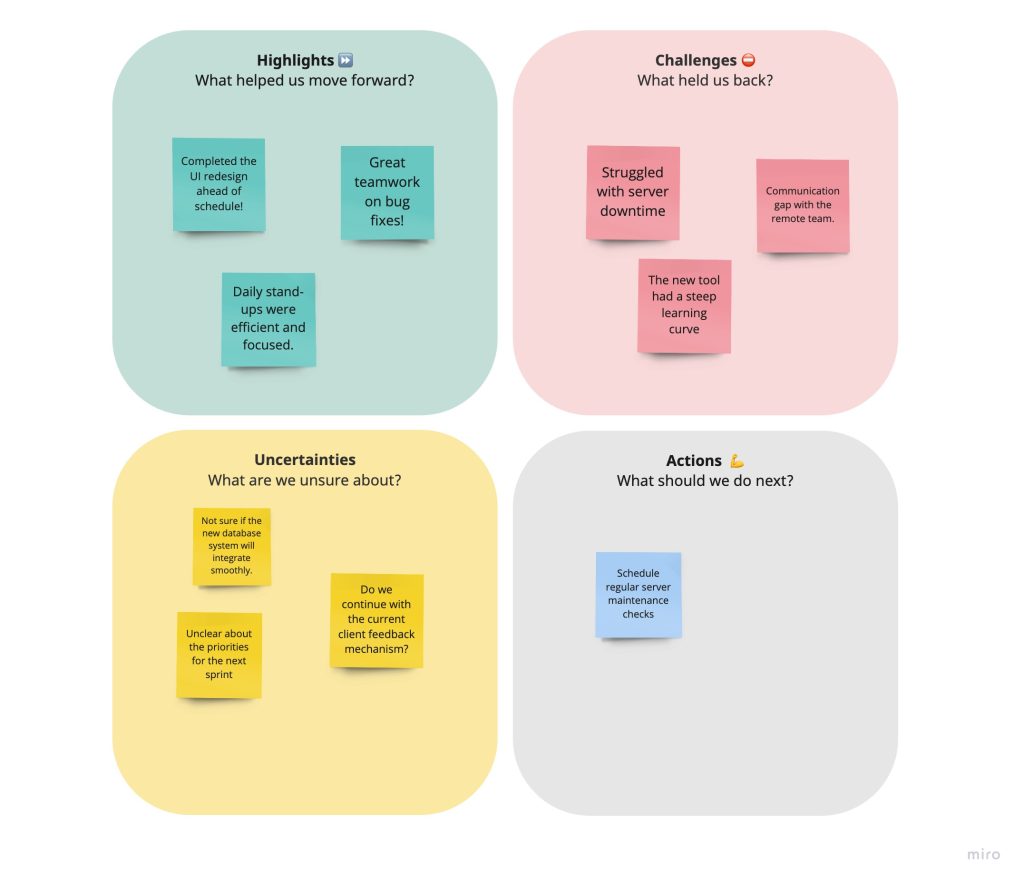
How to Run an Effective Sprint Retrospective Meeting: The Basics
In today’s fast-paced digital landscape, teams across various sectors employ agile methodologies to maintain a competitive edge. Central to this is the Sprint Retrospective, a critical meeting in the Scrum framework. But what’s the fuss all about, and how can you make yours effective? Let’s dive in.
What is a Sprint Retrospective?
At its core, a sprint retrospective is much like a family meeting after returning from a holiday. Held at the sprint’s conclusion (usually every two to four weeks), the team gathers to discuss the highs and lows, what worked, what didn’t, and how the next ‘vacation’ (or sprint) can be even better.

Why is it Important?
Imagine returning from a family vacation and immediately planning the next one without discussing the previous trip’s pros and cons. You’d likely make the same mistakes! Similarly, the sprint retrospective acts as a team debriefing session, helping identify challenges, celebrating achievements, and outlining strategies for the next sprint.
How to Run an Effective Sprint Retrospective:
First stop – What method are you going to use?
Employing the Sticky Note Activity is an effortlessly effective method to conduct a productive retrospective.
Materials Required:Vibrant coloured sticky notes, markers, and ample whiteboard or wall area. For remote teams, digital platforms like Miro or Jamboards serve as excellent alternatives.”
Colour Coding:
- Green: Positive highlights from the sprint.
- Yellow: Areas of uncertainty or things that need clarification.
- Red: Challenges or things that didn’t go well.
- Blue: What actions can we take to remove any current or feature blockers.
Instructions: Ask each team member to reflect on the past sprint for a few minutes. They should write individual observations on sticky notes using the colour-coded system—one statement per sticky note.

Next up – How can you ensure everyone gets involved
Set the Stage
- Purpose: To foster a culture of open dialogue where everyone feels empowered to give and receive constructive feedback.
- Example: Just as a project manager might initiate a post-project wrap-up with clear goals, kick off your retrospective with defined objectives. Stress the importance of open communication and highlight that the intent is continuous improvement.
Gather Data
- Purpose: To consolidate insights and get a holistic view of the sprint.
- Example: Similar to a team collating all their findings after market research, lay out all the events, achievements, and challenges of the sprint. This gives everyone a clear understanding of the sprint from start to finish.
Discuss the Data
- Purpose: To delve deeper into the sprint’s achievements and understand areas that require attention.
- Example: Just as a team might dissect the results of a marketing campaign to understand its hits and misses, scrutinize the sprint’s occurrences. Assess the effective methodologies and identify processes that presented hurdles.

Decide on Improvements
- Purpose: To devise actionable strategies for elevating the next sprint’s efficacy.
- Example: Post a product launch, a team might identify areas of user feedback to incorporate in the next version. Similarly, pin down explicit steps to refine the forthcoming sprint based on your retrospective.
Close the Meeting
- Purpose: To ensure alignment among team members and rejuvenate their enthusiasm for the upcoming tasks.
- Example: Consider concluding a team training session, where everyone acknowledges the learnings and is geared up for application. Summarize the retrospective’s critical insights, ensuring everyone is in sync about the action points and motivated for the sprint ahead.
Tips to Boost Effectiveness
Safe Space
Just as an effective leader ensures psychological safety during team feedback sessions, ensure team members feel confident and secure in expressing their perspectives.
Time Boxing
Similar to effective meetings with clear agendas and timelines, ensure that retrospectives are time-efficient, concise, and pertinent.
Visual Tools
Consider the utility of data visualisation in presentations and apply the same principle here. Employ boards, sticky notes, or digital tools like Trello or Miro to make the retrospective vivid, organised, and compelling.





